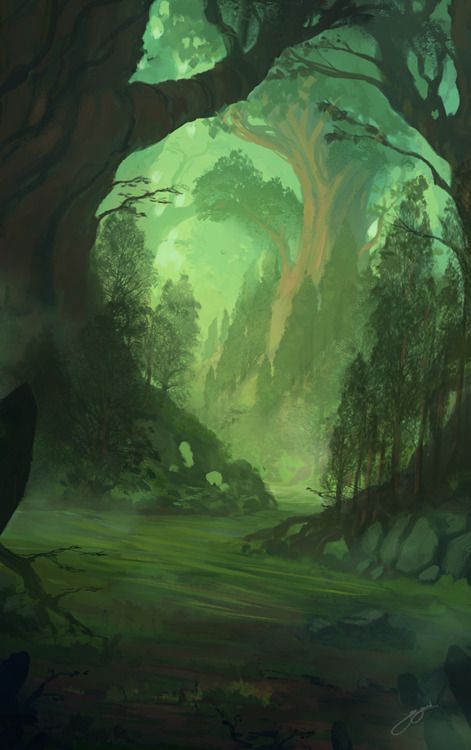Forest of Dungol
A vast and ancient woodland spanning a significant portion of the subcontinent, the Forest of Dungol is a complex tapestry of diverse ecosystems. From the windswept northern reaches to the humid jungles bordering Dungol Bay, the forest breathes with a life all its own.
The forest of Dungol is teeming with life. Every time I visited this location, something new seemed to have found its own corner in the Forest and now calls it their home. -Mattrick Zaffenborgjo
Geography
- Northern Reaches: The northernmost part of the forest is a varied landscape, transitioning from open areas to denser woodland.
- The Heartwoods: South of the open northern reaches, the forest deepens, becoming a realm of towering deciduous trees. Sunlight filters through the dense canopy of oak, beech, and maple leaves, dappling the forest floor. The air is warmer and more humid, and the undergrowth teems with life: ferns, wildflowers, and berry bushes. This is the heart of the forest, home to the ancient Dun'Walis Tree and Dungol City.
- Southern Slopes: As the forest approaches the Blubbermountains, the terrain becomes increasingly mountainous. Steep slopes and rocky ravines replace the gentle hills. Conifers become dominant, their dark green needles contrasting with the grey stone of the mountains. Swift-flowing streams cascade down the slopes, feeding the rivers that wind through the forest.
- Eastern Boundary (Dungol Bay): The eastern edge of the forest meets the sea at Dungol Bay. The coastline varies, featuring stretches of sandy beaches, rocky cliffs, and, in some places, mangrove forests. The air is salty and carries the cries of seabirds.
- Western Border (The Edgewaters): The western border of the Forest of Dungol meets the Edgewaters, a treacherous region of collapsed ocean floor and deep abysses. This area is not part of the forest itself, but its proximity has a significant influence on the westernmost parts of Dungol. The air here is often heavy with mist and a faint, salty tang, and the ground can be unstable in places closest to the edge.
- River System: The Freedom River, the lifeblood of the forest, flows from the central heartwood and empties into Dungol Bay. The Phindolas, Bo-Asha, Jokasta, Redoran, Ollo, and Yikle Rivers originate in the Blubbermountains and flow north into the Freedom River. The Pink Water River also flows into the Freedom River, but its origin is not specified. The Ginash-Uwe River drains the plateau and flows southward, eventually joining the Freedom River. The Freedom River then widens into Gleendale Lagoon before finally emptying into Dungol Bay.
Fauna & Flora
On account of the forest being made up out of several different types the flora and fauna throughout these woods changes from region to region. But some of the more prominent and woundrous things you could find are the Pinkberry Forests.
Regions of the Forest:
- Yiga Forest: Located in the southern slopes, near the Blubbermountains.
- Forest of Pledges: Known for ancient standing stones and clearings where important decisions were made.
- Pinkberry Forests: Groves of trees bearing clusters of vibrant pink berries.
- The Old Road Forest: Contains an ancient, overgrown road.
- The Forest of the Burrowers: Home to various burrowing creatures, making the terrain uneven and treacherous.
- Suckerwood Jungle: A dense jungle closer to Dungol Bay, with thick vines and dangerous wildlife.
- Weylanu's Backwoods: A remote and wild area in the southern part of the forest, possibly named after a legendary figure.
- The Forest of Whispers: A dense and shadowy area where the wind carries whispers and murmurs. Home to the druidic circle.
- The Wasted Copse: Located in the northwestern reaches, near the Ginash-Uwe Plateau.
- Blackpine Thicket: A dense thicket of black pines, making it dark and difficult to navigate.
- Juju Tree Bush: A grove of trees with glowing, bioluminescent leaves, believed to have magical properties.
- Coldfeet Forest: A cold, marshy area in the northeast.
- The Salt Marshes: Located near Dungol Bay, influenced by the tides.
- The Cold Marsh: A large, stagnant marsh located in the central part of the forest.
- The Grey Wardens: A range of tall, imposing mountains in the west.
- The Black Rangers: A jagged mountain range with dark, volcanic rock.
- The Little Rangers: Smaller mountains or hills near the Black Rangers.
- Mount Yikle: A prominent peak in the southern part of the forest.
- The Yiklespine: A long, jagged ridge extending from Mount Yikle.
- The White Guardians: Mountains covered in perpetual snow, located in the far south.
- Cliffs of Zaki: Steep cliffs overlooking the Edgewaters.
- Belvonte Mountains: A large mountain range in the south of the continent, partially covered by the forest.
- Ginash-Uwe Plateau: Located in the northwestern part of the forest, near the Wasted Copse.
- Freedom River (Flodamiel River): The main river, flowing from the central heartwood into Dungol Bay.
- Phindolas, Bo-Asha, Jokasta, Redoran, Ollo, Yikle Rivers: Originate in the Blubbermountains and flow into the Freedom River.
- Pink Water River: Origin unknown, but flows into the Freedom River.
- Ginash-Uwe River: Originates from the Ginash-Uwe Plateau and flows south into the Freedom River.
- Gleendale Lagoon: Where the Freedom River widens before emptying into Dungol Bay.
- Redd's Cove: A small, sheltered cove on the coast of Dungol Bay.
- The Edgewaters: A region of collapsed ocean floor and deep abysses on the western edge of the continent.
- Dungol Bay: The body of water forming the eastern boundary of the forest.
Natural Resources
All kinds of resources make their way out of the forest. From lumber for the airships, to special herbs for medicine.
Alternative Name(s)
The Forest in the North, The Elfwoods, The Forest of Many
Type
Forest
Location under
Included Locations
Included Organizations
Owner/Ruler
Owning Organization
Related Ethnicities
Inhabiting Species
Related Myths
Related Plots




Comments